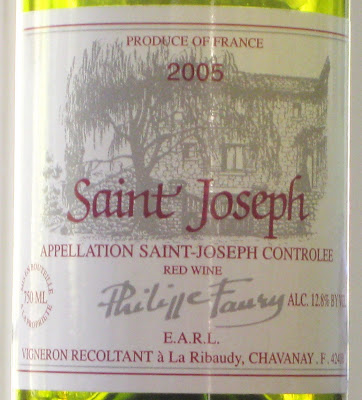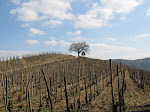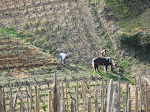
Tuesday, November 4, 2008
Election Night

Saturday Night Football - 11/1

Sunday, October 26, 2008
Saturday Night Football - 10/25

The Bobo clan gathered for the big Penn State vs Ohio State showdown Saturday night. In an attempt to stay awake for the entire game, I selected a couple lighter alcohol wines for the evening. 2006 was a ripe warm vintage in the Wachau and the Franz Hirtzberger, Gruner Veltliner, Federspiel, Rotes Tor reflected those conditions. This vintage was richer and riper on the palate then usual for this bottling. Hirtzberger is located in Spitz at the western end of the Wachau, where the cool air gets trapped as it flows down the Wachau. This area tends to produce wines that are racier and more mineral driven than those from the rest of the Wachau. The main flavor I found in the 2006 was banana, which I often find in Gruner Veltliners from warm vintages (such as 2003). In contrast, the 2004 version of this wine was bright and lean. Hirtzberger is a very skilled producer and despite its richness, the wine was framed by an elegant texture. While I enjoyed this single vineyard cuvee, I find myself less enamored with Gruner Veltliners in general. The top producers in the Wachau usually charge the same amount for their Gruner Veltliners and Rieslings. Personally, I would rather consume a Riesling.

The next wine screamed northern rhone from the start. A good dose of black olive hit my nose as I sniffed the Phillipe Faury, Saint-Joseph, rouge, 2005. The wine was pure and elegant in the mouth. While traditionally styled, this wine was fruitier than the benchmark wines made by the great Raymond Trollat. It was a joy to drink a serious wine that weighed in at only 12.8% alcohol. I actually made it to the third quarter of the Hawaii game, which started at midnight!
Monday, October 13, 2008
Burgundy's great hidden treasure

"Is that really seven barrels of Montrachet?" I asked.
"Yes", our French associate replied. "The other 18 went to negociants."

 An interior view of the entrance to Domaine Thenard's cellar.
An interior view of the entrance to Domaine Thenard's cellar.The estate was founded in 1842 by Baron Paul Thenard, who married a local girl with the last name of Bordeaux-Montrieux. In subsequent years, control of the domaine passed through the female side to the Bordeaux-Montrieux descendants. Despite being virtually unknown in the U.S., Domaine Thenard has been famous in Burgundy for over a century due to one monumental purchase. Two large parcels of Le Montrachet, totaling 1.86 hectares, were acquired by Baron Paul Thenard in 1872. Only the Marquis de Laguiche, with their single parcel of 2.06 hectares (Puligny side), own more land in this fabled vineyard. By comparison, the third largest owner in Montrachet is Bouchard Pere et Fils with 0.89 hectares. In the 20th century, the grand cru vineyards Clos du Roi in Corton and Les Grands Echezeaux in Flagey were added to the portfolio. These vineyard acquisitions made Thenard one of the most important estates in Burgundy, yet the heart of the domaine remained in the humble village of Givry.

Baron Jean-Baptiste Bordeaux-Montrieux
Baron Jean-Bapstiste Bordeaux-Montrieux has been in charge of the winemaking at the domaine since the earily 1980's, but most of the wine was sold to Remoissenet while still in barrel. The bottles sold under the Remoissenet label were not held in high esteem, but the cuvees purchased from Thenard stood out. In his description of Remoissenet, Clive Coates (The Wines of Burgundy, University of California Press, Berkeley, 2008) wrote, "the firm distributes the wines of Domaine Baron Thenard and these - Le Montrachet, Corton Clos du Roi, Grands Echezeaux - are often the best." Maison Entienne Sauzet also purchases the Montrachet in must form from Thenard and this is the sole source for their much sought after cuvee. Today, the Baron holds back the top cuvees for the estate and controls every step of the winemaking. The wines bottled under the Domaine Thernard label are serious vin de garde (wines to keep). I was blown away by a 1976 Givry rouge tasted at the domaine during our visit. Amazingly, the wine was still very much alive.

The winemaking at Domaine Thenard is very tradtional and the wines have a firmness/rusticisty that reflect that style. The domaine's largest holding in Givry is in the premier cru Les Bois Cheveaux (7.66 ha), which tends to show slightly more power then the Givry premier cru Cellier Aux Moines (3.22 ha). Also in Givry is the premier cru Clos Saint-Pierre (2.12 ha). This vineyard, which is a monopole of the estate, produces the darkest colored and most ageworthy of the three Givry premier cru. In Pernand-Vergelesses, Thenard owns a piece of the finest vineyard in the village, Illes des Verglesses (0.85 ha). Right next door, on the hill of Corton, sits the domaine's prime parcel in the great Clos du Roi (0.9 ha ). The top section of Clos du Roi, where Thenard's vines are located, is considered superior to the lower portion of the vineyard and produces one of the more underated grand cru in Burgundy. Clive Coates considers Clos du Roi to be one of the very best vineyards in the Cote d'Or, on par with La Romanee Conti, La Tache, Chambertin and Le Musigny. Also included by Coates with those legendary names is Les Grands Echezeaux, of which Thenard is fortunate to own 0.54 hectares.
Three white wines are made at Domaine Thenard. The basic Givry blanc is fresh and bright. Far richer and more intense is the Chassagne-Montrachet, 1er Cru, Clos Saint-Jean (0.17 ha). The show stopper is, of course, the Le Montrachet (1.83 ha). In addition to owning a huge portion of this vineyard, the domaine is also blessed with old vines. The individual parcels were planted between 1931 and 1972. The resulting wine is deep in color and has an intense bouquet of white flowers and spicy oak. In the mouth, the wine is immense, but not heavy. A wave of minerals lurks in the background and keeps the wine from weighing down the palate. Thenard's Montrachet is truly a great wine.
Thursday, October 2, 2008
#@$%&%$! on Le Chambertin
Wednesday, September 24, 2008
Tomato Pie Night - 9/24

Saturday, September 20, 2008
Champange Sunday - 9/21














